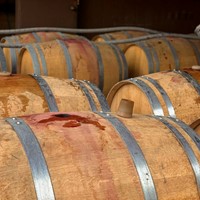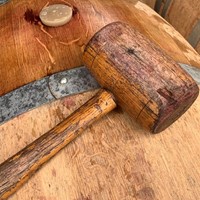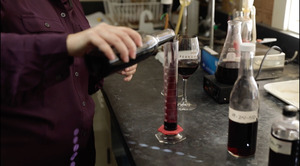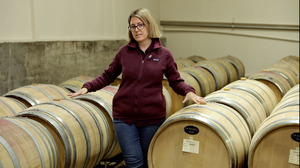Wine Barrels
-
Barrels Inside & Out
February 22, 2022 09:42

Have you ever wondered what barrel tasting really means? Are you curious about why wine is aged in barrels at all-what is the point? What happens during the aging process and what exactly is ‘angels’ share’? Today’s note includes answers from winemaker Montse Reece and cellarmaster Polo Cano.
First we’ll start with a little Barrel 101. How big are those barrels? We use 59 gallon size barrels which holds enough wine for about 24 cases, give or take a bottle or two. Why do we barrel age wine at all? Think about it in this way. If you have a raw piece of wood that needs the edge taken off and you’d like to use it as a frame, you’d take it to the shop and start sanding and shaping it. The same thing happens in barrel-the wine is raw and rough when it is transferred and over time helps to smooth out those rough edges.
There are more benefits to aging including aeration, concentration and oak notes like toasting-something the cooper (barrel maker) does to increase the flavor components in the barrel. The process gives the wine, over time, more complexity as it takes on some aspects of the wood itself. Aeration slowly incorporates air thereby smoothing the tannins; concentration-with evaporation of water and even alcohol you get concentrated flavors and in fact we lose about a gallon or two to this process.
I asked two questions: Why is it important to top barrels and why is it important to take time to taste from the barrel?
From Polo:
"Topping to replace the lost wine through evaporation (every three months is the ideal timing). It gives us a chance to smell every barrel and to see how it is aging and to see how the new oak is integrating with the wine (to catch and separate odd smelling barrels if any). To adjust the free Sulphur in the wine so it stays protected."
From Montse:
"Barrels aren't completely airtight, so after a while the evaporation creates a headspace, also known as ullage. The concentration of free SO2 declines faster in barrel than in a tank due to oxygen exposure and should be checked every 1 to 3 months depending on the circumstances. It’s important to keep the barrels full to avoid oxidization and bacterial spoilage that can ruin the wine. (Editor's note: And this is what free sulphur does-it acts to prevent spoilage which would in turn develop undesired aromas-it is a very fine balance to maintain!).
Before we start topping it’s important to smell and taste if necessary from every barrel to detect off aromas that can be a clue for spoilage or oxidization. If confirmed, the barrel is isolated from the rest and treated accordingly.
You look for pretty much the same when you taste young or longer aged wines in barrels: hints for spoilage or oxidization. On the positive side, I look for fruitiness and acid integration in young wines and oak integration, aging evolution of the varietal flavors on the older wines."
What is the angel’s share? The portion that is lost over the year (or more) the wines age-evaporated away poetically into the heavens.
Polo wraps up this note perfectly. “It is kind of a time to wake your baby up, see that it is ok, feed it, play with it and put back to sleep.” -
Seasons in the Cellar: Winter
January 17, 2022 09:46
 Last year I had Marcus Cano, son of our cellarmaster Polo, film winemaker Montse Reece and fourth generation member Mitch Blakeley-in the cellar and the vineyard respectively through four seasons. Marcus followed Montse into the Barrel Room and her lab.
Last year I had Marcus Cano, son of our cellarmaster Polo, film winemaker Montse Reece and fourth generation member Mitch Blakeley-in the cellar and the vineyard respectively through four seasons. Marcus followed Montse into the Barrel Room and her lab.
As you will see there is a lot going on in the cellar at this time of year. She guides you through two of her tasks: blending our Mother Clone Zinfandel and barrel aging. Before you dig into the videos though here is Montse’s background-she just celebrated her 15th harvest with us. We have had 3 lead winemakers in our 95 years! My grandfather, my uncle John with 65 vintages and now Montse.
She is a native of Spain and earned her degree in enology from the University of Rovira i Virgili in Tarragona, Spain. She then worked for wineries in the Penedés and Montblanc regions during this time. Once finished with college she came to California and joined the harvest crew at Gloria Ferrer Champagne Caves in Sonoma in 1998. After that she was hooked and held positions at both Ferrari-Carano and Rodney Strong Vineyards. She joined the winemaking team at Pedroncelli Winery in 2007 as assistant winemaker to John Pedroncelli, Winemaker Emeritus.
“I consider it an honor to have had the privilege of working with John Pedroncelli for as long as I did,” says Montse. “His passion and love for the vineyards and wines of Pedroncelli will continue to be present in the style and spirit of this winery for generations to come.” Montse was named Winemaker in 2015 and she focuses on the details and unique qualities of each vineyard block. She maintains the continuity of the Pedroncelli style and works together with Vineyard Manager Lance Blakeley and Cellar Master Polo Cano who make up the winemaking team.
Categories
- COVID
- Follow the Vineyard
- Note from Home
- PairItWithPed
- Pandemic
- pedroncelli
- Port
- Postcards from Home
- Pruning
- Seasons in The Cellar
- Tasting Room
- Thanksgiving
- Vintage Notes
- Winemaking
- Women's History Month
Recent posts
-
91 Years Later
-
Come Over October: It's About Community
-
Come Over October
-
A Legacy Continues!
-
Everything Old is New Again
Popular tags
- Sonoma County
- food and wine
- COVID19
- Finding Your Roots
- Barrels
- Bushnell Vineyard
- Cabernet Sauvignon
- Lake Sonoma
- Merlot
- Reserve
- Dry Creek Valley
- Habit
- Four Grapes Port
- Estate Vineyard
- Pruning
- newsletter
- Oak
- note from home
- Easter
- Block 007 Cabernet Sauvignon
- Rosé
- Pandemic
- Recipes
- OpenThatBottleNight
- Sauvignon Blanc
- family
- Follow the Vineyard
- Crop set
- Down to Earth
- Anniversary
- Seasons in The Cellar
- 1974 Cabernet Sauvignon
- cheese
- Cookies
- Mother Clone
- Schotzki
- Courage Zinfandel
- American Oak
- Holding steady
- Pedroncelli
- PairitwithPed
- Pantry
- Library Wine
- cooking with wine
- French Oak
- Homecooking
- Heat wave
- Harvest 2022
- COVID Coffee Chat
- Cellar Master







